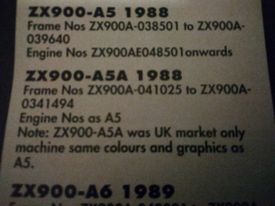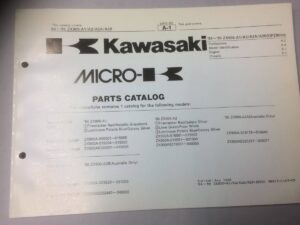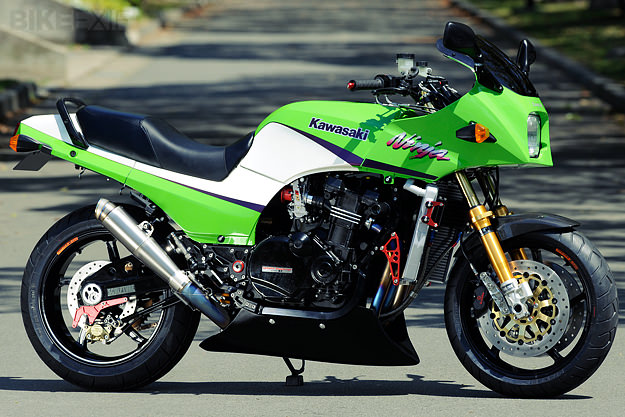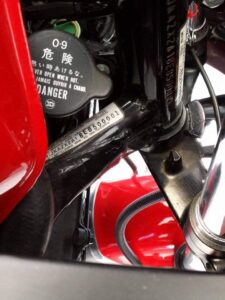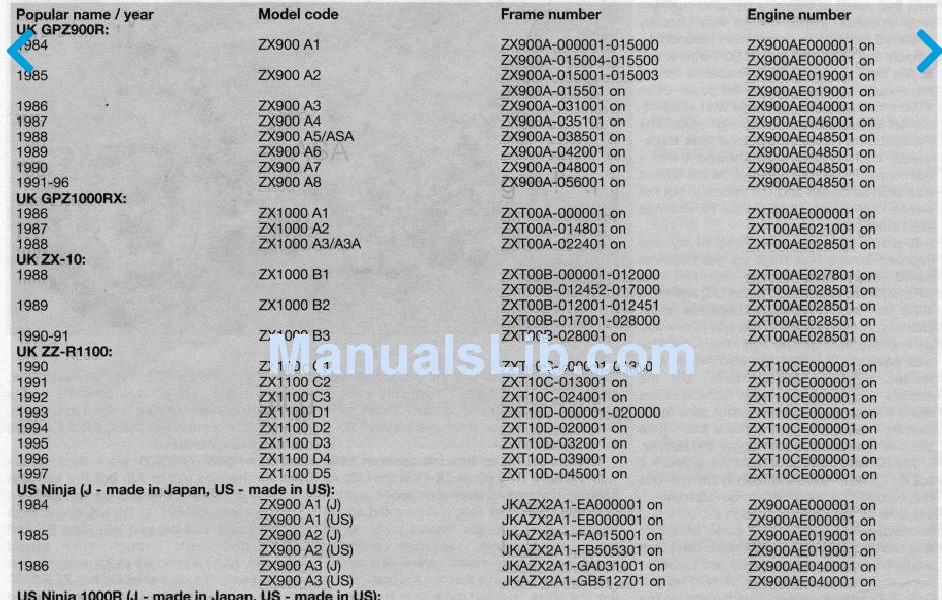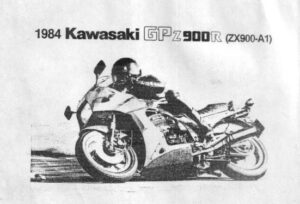Resources
General Info
The GPz900R was released to the public at the Paris Motor Show in 1983. Although officially released in 1984 in Australia it was on dealership floors in late 1983 and production only finished two decades later in 2003. I believe the last the production bike was #97162.
A production run this long is admirable for any motorcycle, but what makes it unique is that it was the fastest motorcycle in the world. Even today a +150mph, 3sec (0-60mph) and 11sec (1/4 mile) bike is no slouch, and rather than comparisons with modern machinery needs to put into context. Back then that performance meant you were basically the fastest production machine on the road, beaten in top speed by only a handful of cars.
Today’s superbikes are wondrous machines but are *well beaten* in top speed by scores of supercars. Almost out-accelerated too.
In motorcycling ‘fastest’ is marketing nirvana, so few vehicles get to wear that crown for long. And that was the case for the GPz, soon out-muscled by newer machinery. It’s successor the 86-88 GPZ1000RX? Marginally faster at the expense of other criteria. Built for only 3 years. The wonderful 1986 Suzuki GSX-R750, purpose-built for 750cc superbike racing, still in production but in name only. Faster on a race-track? Yes, but not by much. Easier to ride and a better on the road? Not by a long shot.
The GPz design was arguably the first sports-tourer, and if you could only own one bike this was it. Daylight to second. She out-lived her replacement, the 1986-1988 GPZ1000RX, that bikes replacement, the 1988-1990 ZX-10 Tomcat and even that bikes replacement, the formidable 1990-2001 ZX-11. It was still being sold in an market that included the Ducati 916, the Yamaha R1, the Honda CB900RR.
The Vincent Black Shadow, another fastest motorcycle in the world, is regarded as the first superbike . Expensive, exclusive, fast and dangerous. The legacy of the GPz is it took the extreme performance of machinery like the Vincent and handed it to the average rider on an affordable gold platter.
It single-handedly brought the masses to performance motorcycles and in doing do shook the foundations of the entire industry. It sowed the seeds of the modern superbike, because it required specialist race-focused designs to beat it. It was the ultimate production performance motorcycle, the ultimate motorcycling decathlete.
There will simply never be another motorcycle like it.
Other sites dedicated to the GPz900r.
GPz900r or GPZ900R?
You have to have a bit of a giggle at Kawasaki.
Despite spending six years in great secrecy developing an industry-changing motorcycle in 1984 the branding from that era it still confusing. Let’s roll back a year to 1983 and the Kawasaki family of road bikes is the GPz series. All air-cooled, two valves per cylinder, cradle frame and nose-cone fairings.
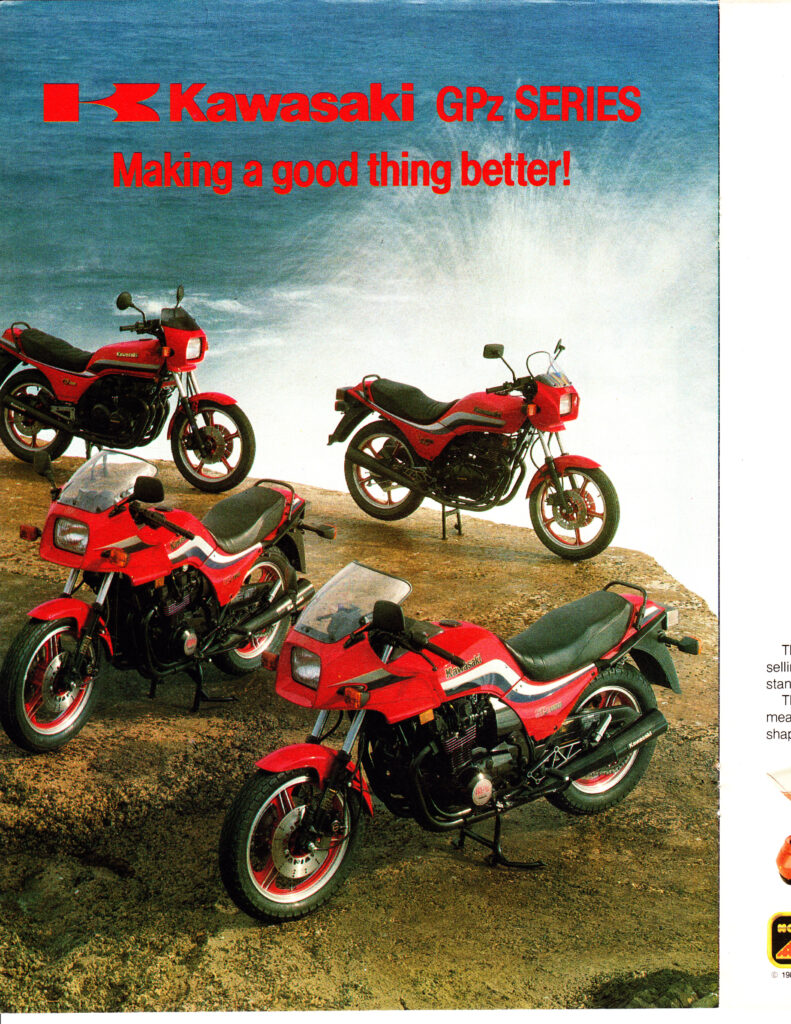
So in some ways it’s not surprising that the new bike kept this family name – hence the GPz900R – the ‘R’ representing ‘Racing’. But it was a totally different machine even to the fully-faired GPz750 Turbo, new frame, new engine, pretty well new everything. And as for “Racing”? Well at that time the most marketable category was US Superbikes – which were limited to 750cc! Yes the GPz750R version was also released in 1984 as well as official competition mods, but the simple reality of putting a smaller engine into the identical-in-every-other-way tells you how “serious” Kawasaki really were…….they weren’t even green!
So yes there is a 1983 GPz750 & a 1984 GPz750R but they are totally different bikes! Still confusing to many even today as shown in this motorcyclespecs.co.za ink. And then just a year later in 1985 Kawasaki released the GPZ600R.

All GPZ600R graphics and literature refers to a capital ‘Z’, and this scan from a dealership brochure also shows how they are still referring to the ‘old’ GPz550 and the ‘new’ GPz900R – both clearly written with a lower-case ‘z’. So I’m pretty sure ALL bikes released from here were capitalised GPZ, including the Ninja’s successor the GPZ1000RX.
Why ‘RX’? Well in 1987 Kawasaki released a limited run of the GPZ600R with an aluminium frame, the GPZ600RX. Six kilograms lighter too, so I’m assuming the :”X” stands for “eXtra”? Interestingly these aluminium framed bikes started with japanese-only GPz400R. Remember no FEA or computing grunt in those dys, so Kawasaki chose to limit the release of these “fragile” frames to their own domestic market first!
Of course the GPZ1000RX frame is steel not aluminium, but I suspect at that time Kawasaki were scrambling to catch up with new bikes from other manufacturers so were taking every performance-related reference they could find.
FWIW the GPZ600, in partuicuklar the RX version, is a very under-rated machine. Arguably the catalyst for the hugely successful 600 Sports Bike category.
In 1991 the Kawasaki reference to the revamped A7 Ninja is clearly branded GPZ900R and the frame numbers change as well. In one of the articles below a journalist noted that the official branding of the bike was definitely changed from ‘z’ to capital ‘Z’ for A7+ bikes which represented liquid-cooling, which if course distinguishes them from the ‘old’ air-cooled bikes and makes sense as every bike since the GPZ600R has a capital ‘Z’. However I suspect that there is other Kawasaki marketing material which is describing 1st gen bikes as GPZ as well.
Of course all Ninja’s are liquid cooled… lol! and to keep it even more confusing despite changing fairing stickers the engine decal (used as the site logo) on every bike are GPz Kawasaki, so I guess the Kawasaki marketing budget simply didn’t extend to that level!
History
History
Despite extraordinary performance for 1984 (still the 17th fastest production bike – ever!) the impact of the GPz900R is of much greater significance for:
- performance motorcycle design
- Kawasaki motorcycling division
- the motorcycling industry
- the motorcycling market
Performance Motorcycling Design
The GPz was significantly better at nearly everything than any air-cooled performance bike. Even Kawasaki’s own 750 turbo, considered the best of the blown bunch. Perhaps this shouldn’t be any great surprise, six years of development should create a significantly better motorcycle (see below).
Despite Kawasaki themselves claiming the GPz750R was the Production Superbike version, I simply do not believe the bike was ever designed to be a race-track bike. The idea of putting a lighter, smaller engine into a frame for a road-oriented 900 and assuming it would be race-track competitive is completely at odds with the focused design principles Kawasaki applied to the 900. My guess is this was simply marketing.
However the surprise of the design was that not only was it clearly the best road performance motorcycle, it was as good (if not better) on the race track than contemporary race-oriented machinery from larger manufacturers like the Honda VF1000R. To be beaten by a road bike would have been both humbling and probably shocking for Honda, at that time the dominant motorcycle manufacturer and a long history of Production Superbike success. The bikes competitiveness against purely GP-inspired machinery from Yamaha & Suzuki must have also made them sit up and take serious notice.
The GPz900R was the ultimate road performance motorcycle.
It was so good and so polished that from that moment performance motorcycle designs had to become more specialised and no longer have a road bike as their core DNA. The first and the last of it’s kind, there will never be another motorcycle like it.
Kawasaki Motorcycling Division
It is probably still a surprise to many but Kawasaki isn’t based on motorcycles, this is only a very small part of the company. Some interesting facts from 1979.
- Only 10% of the company turnover is motorcycles with only single-digit Japanese market share
- US market share: Honda 36%, Yamaha 25.8%, Kawasaki 15%, Suzuki 13%, Harley Davidson ~6%
- Honda: 60 models = global sales of 2.5million bikes per year, Kawasaki 25 models = 300,000 bikes per year
- They were the first Japanese manufacturer to have a US assembly plant, US bikes built by US employees
There is no question that the GPz900R was a motorcycle designed & built for the US market.
There is also no question that the commercial success of the Ninja in the US must have been pivotal in the commercial success of the Kawasaki motorcycles. Given the significant development investment by such a small manufacturer, one wonders where Kawasaki motorcycles would be today if the GPz900R had simply been a modest success, let alone a sales failure.
The pressure to succeed must have been enormous.
The incredible impact and success of the GPz900R has created the immeasurably successful Ninja brand for Kawasaki, arguably the most recognisable name in performance motorcycling today. The GPz900rR (and the K1) are arguably the most important motorcycles ever built by Kawasaki.
The Motorcycling Industry
History suggests that most performance motorcycling design before the GPz900R had become stagnant. The 1983 Suzuki Katana is a glorious motorcycle, but looks ancient compared to the 1985 Suzuki GSX-R750. Large-capacity air-cooled machinery like Kawasaki’s own KZ1300 were the typical performance motorcycle, and in retrospect the industry model of shoe-horning large engines into un-refined frames & suspension looks both lazy and dangerous.
And this gave Kawasaki an opportunity. As a small player they needed to spend their R&D dollars wisely and identify a market where they potentially could have an edge. But a performance motorcycle is risky – it’s high-tech development and potentially expensive due to the ‘Law of Diminishing returns’. there is no question that with such a long developemt time secrecy would have been absolutely vital.
The Kawasaki design brief was brilliant – optimise rather than create. Yes the bike has some cutting-edge technology for 1984 but it’s performance is summarised by the famous Aristotle quote:
The whole is greater than the sum of its parts.
Although not a race-track design, the GPz clearly exhibits race-track design principles where every component is carefully evaluated for suitability & performance. The fact that it was better than it’s race-track inspired contemporaries shows that although other manufacturers may have *thought* they were applying race design philosophies – there was still significant room for improvement.
Fast was no longer enough, the GPz900R significantly lifted the bar for a road-oriented performance motorcycle. And the GPz900R made it crystal clear that to be at the pointy end of town required a significant amount of manufacturer R&D.
Like the Honda CB750, from this moment motorcycles simply became better. A seminal moment for the industry.
The Motorcycling Market
The GPz900R single-handedly brought the masses to performance motorcycles.
In 1984 all of the bikes performance competitors were far more race-oriented, often uncomfortable and hard to ride. Fast motorcyclists were generally classified as experts or just crazy.
The GPz900R opened the door to a new and extremely profitable performance motorcycle market. Not only was it affordable, but it was easy to ride and incredibly versatile. Performance, touring, urban riding – it could do it all. And in 1984 it was blisteringly fast and immediately recognisable – arguably one of the very first motorcycles that could intimidate simply by reputation.
Ultimate performance, intimidating reputation yet refined enough to be ridable by mere mortals – the recipe of the modern superbike and supercar. The only significant difference is that the GPz was actually affordable.
Versions
Versions
There were 16* official versions of the bike prefixed by the common letter ‘A’ and a number – so the first version was A1 (1984) & the last A16 (2003). The different colour schemes are discussed here.
Note that there are different specification bikes for each version (detailed in the Kawasaki service manual) depending on the market – often it was a power restriction to comply with local laws (eg. Germany). Power is outlined below.
US & Canadian A1, A2 & A3 bikes were built/assembled in the US Kawasaki plant in Lincoln, Nebraska, the rationale was to reduce import tariffs. These bikes have slightly different frame numbers (see VIN section) to the Rest of World (RoW) bikes manufactured in Akashi, Hyōgo Prefecture, Japan. There is a fair argument that the US bikes are the true ‘Ninjas’ as this name wasn’t used for other markets until much later.
*The A5A
From 1984 (A1) to 1993 (A10) the version numbers simply increment annually. However in 1988 there is an oddity – the A5A. This is the only variation listed in the Factory Service Manual (FSM).
Mar 2021 – Update: Based on research & schematics it seems probable that the A5A bikes were the ones that were supplied with the carburetor de-icing circuit. Analysis (limited online options) suggests that these bikes were likely always red, possibly black and unlikely to be blue.
The carb icing was a significant issue for Kawasaki requiring a factory recall/free replacement, so as this likely occurred mid-year and didn’t fit with the standard annual-version release, the use of A5A was possibly an easy way for dealers to identify the bike.
*The A2A & A2B
Although not listed in any FSM I have seen (only later ones though) this image of an official Kawasaki microfiche does identify specific variants for the A2. I haven’t found these A & B variants for any other version (except A5) so it’s arguable that these should be also considered official versions.
I have no idea what makes these different to a standard A2.
First Generation: A1 (1984) to A6 (1989)
Note: although ‘officially’ the bike was released in 1984, owners have reported that the bike was for sale in Australia in late 1983. This is our summer (so prime time for bike sales) and definitely plausible as both Japanese & European manufacturers often used Australia as the early ‘test’ for machinery.
The original bike was the performance milestone for ALL motorcycles – and is easily recognisable by the 16″ front wheel used by many manufacturers of that time. This was taken from the GP bikes of that era so wasn’t simply marketing and despite looking small by today’s standards all reviews of the bikes handling are exemplary for the time.. The bikes also had the cutting-edge AVDS (anti-dive) which was reviewed very favourably, and although fiddly to service & maintain (so later removed) it highlights that Kawasaki engineers knew that front fork improvements were a core part of a performance bike design.
There is some debate as to dealership sales of the bike in the US. Many people strongly say it was ONLY available from 1984-86, matching the US assembly dates. But….the FSM has US spec-bikes for all versions, so it seems peculiatr that Kawasaki would have a US-spec bike if it wasn’t being sold there.
US bikes had different handlebars & peg positions for a more upright riding position and had a shorter mudguard (shared with Australia) than European spec bikes. The bikes often had different power outputs (due to different carb specifications) based on their market, some European countries had maximum limits.
*Power figures are taken directly from the Factory Service Manual.
A1+A2: max power 115hp @9,5000rpm unless noted.
- (C) Canada – 110hp
- (Cal) California
- (I) Italy
- (S) Swiss – 69hp @6,000rpm
- (SA) South Africa
- US United States – 110hp
A3: max power 115hp @9,5000rpm unless noted.
- (A) Australia
- (C) Canada – 110hp
- (Cal) California
- (F) France – 74hp
- (I) Italy
- (S) Swiss – 69hp @6,000rpm
- (SA) South Africa
- (Swe) Sweden – 100hp
- (US) United States – 110hp
- (WG) West Germany – 100hp
A5/A5A + A6: max power 115hp @9,5000rpm unless noted.
- (Ari) Austria – 110hp
- (A) Australia – 105hp (CVK32)
- (C) Canada – 110hp
- (Cal) California
- (F) France – 74hp
- (I) Italy
- (S) Swiss – 69hp @6,000rpm
- (SA) South Africa
- (Swe) Sweden – 100hp
- (US) United States – 110hp
- (WG) West Germany – 100hp
Some notable changes to versions, there will be others not listed here!
- oil pipes inside the head (4mm to 6mm)
- change from single to push-pull throttle (A3)
- carb de-icing circuits introduced for cold markets (A5/A5A)
- crankcase bolt changes
- rear shock top bolt 10mm to 12mm
- 86-89 bikes were also available with the smaller CVK32 carbs.
- engine & transmission changes
- for more info see Technical-Quirks
Second Generation: A7 (1990) to A10 (1993)
In 1990 the bike was re-marketed as a sports-tourer, fundamentally the same bike with only minor changes. Most European marketing finished in 1991 with the A8, the A10 was only officially released in Germany and the Netherlands. I’ve not heard of any bike later than A8 in Australia either.
A common question from owners is why is the max power is down to 108hp from 115hp. Technically it’s probably pretty simple – breathing.
2nd gen bikes have an airbox that has only 50% of the intake vent area, a different needle & main jet as well as larger silencer baffles. As a sports-tourer it seems likely that Kawasaki would tune for rideability and fuel-economy more than pure performance, magazine articles suggest Kawasaki also modified the intake to ‘reduce intake noise’.
This is ironic as many modern owners try to fit pods (good luck!) to get MORE intake noise!
The maximum main jet factory specification is the *significantly* smaller #108 vs #132. Keihin main jets sizes represent the diameter of the jet (ie #132 is 1.32mm), which means the area is 0.916mm vs 1.496mm. So early bikes could theoretically jet 50% more fuel. Despite this reduction in *potential fueling* it would only ever affect a CVK at maximum engine CFM, NOT maximum throttle opening. So the performance of the 2nd gen bikes is still outstanding and most riders say it is almost impossible to tell the difference when riding on the road.
A7: max power 108hp @9,5000rpm unless noted.
- (SA) South Africa
- (SW) Sweden – 89hp
- (W) West Germany – 100hp
*no idea why Sweden changes from (Swe) and West Germany from (WG). Maybe to save ink…..!
A8-A10: still to locate the official factory specifications
Some significant changes, there will be others not listed here!
- 17″ front and wider rims (150/70/18 rear)
- different silencers (shorter with larger internal baffles)
- in 1992 starter clutch reliability improved (changed from roller to sprag) – but only for Japanese & Malaysian bikes!
- cam chain tensioner upgraded
- AVDS removed & larger diameter (41mm) forks – air pre-load removed.
- handlebar mounting now completely covers fork top tube – up until A10 available as either single or two-part construction
- larger floating front disc & 4 pot brakes
- different mirrors (much better rear view) & foot-pegs
- *Japanese bikes have single pulsar coil (all other markets keep the original dual pulsar coil)
- different fuel tank system (no discrete tank breather line)
Third Generation: A11 (1998) to A16 (2003)
As this bike is fundamentally the +A7 version it is debatable as to whether this should be defined as a unique generation. However in 1993 production of the GPZ900R ceased after an incredible production run of 9 years – that alone is amazing for a performance bike design. Dead and dusted right? No, because 5 years later in 1998 they re-started production due to customer demand.
Remember 1998 is the era of the Honda CB900RR, the Yamaha R1 and the Ducati 916.
The fact that a 14 year old performance design was still commercially viable is simply unheard of in motorcycling history, this alone justifies a distinct generation.
Recently online (70,80′ & 90’s bikes) I asked about other machines with 20-odd year lifespans. Very specific – it had to be virtually the same bike so anything with “major” releases or changes doesn’t count. There aren’t many, the criteria seems to be cheap, reliable & simple designs like the Honda Cubbie and Suzuki GS500E. Interestingly the Honda XR650, Kawaski KLR650 and Suzuki DR650’s *all* have long production runs. Obviously a very strong market, perhaps these were the early adventure bikes? The only other “performance” bike identified was the great Yamaha VMax, and no other “sportsbike” comes anywhere near the GPz900R’s production run..
As mentioned the engine, gearbox & frame are basically the original 1984 design, the rest of the bike is 2nd generation with the following updates.
Information on these bikes is very limited as they were only released in Japan/Malaysia (A10/11) and then just Malaysia.
- coil-over rear shock (replacing air)
- from 2000 rear suspension had grease nipples (useful)
- later versions had 6-pot front brakes
- different front forks*
The 6-pot calipers will fit 2-gen bikes, but analysis of schematics & part numbers shows that the +A12 bikes did have slightly different front forks. Yokes and handlebars the same so guessing still 41mm top tubes, however it does look like these forks have preload adjustment.
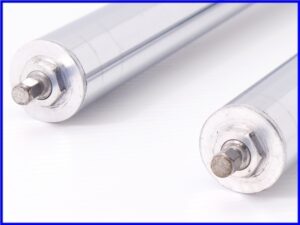
What is potentially interesting is that you can purchase a cartridge insert system (Matris F15) for +A12 bikes. Why this and not +A7 forks No idea. And given the way the handlebar bracket fits *over* the top tubes for +A7 bikes I have no idea how this cartridge insert, with top adjusters, would even fit! Again the issue here is there is simply no information on these Malaysian/Japanese bikes easily available.
The other interesting fact is that +2000 bikes could use the same engine & cylinder head cover as 1986 US bikes! So this suggests the parts were shipped back to Japan from the US and sat in a warehouse for 14 years before being reused. Amazing!
Collector Bikes
The A1 is the obvious collector’s bike.
They are becoming more & more collectable as they age, they do represent a significant leap in motorcycling development that it etched into the memory of many riders.. Mine draws a crowd whenever I park it amongst other bikes. A true iconic motorcycle.
But collector value is either rare or classic. Most enthusiasts define the Z1 as a classic, yet more of these were produced (~84,000) than the GPz (~70,000) so neither is ‘rare. Ironically the most likely factor working against the GPz as a collector çlassic bike is that was so revolutionary for 1984 that it is still considered ‘modern.
In 2020 an Australian eBay bike was advertised for AU$25,000 and in May 2021 there was another A1 with an asking price of £12,345 (AU$22,212).
I would use the classic Aussie quote for both: tell him he’s dreaming’
The reason is neither of these were true low-mileage concourse bikes, neither had any sort of racing pedigree or history. So IMHO these are long shots. For a concourse bike I think asking north of AU$10K is quite fair and reasonable, maybe even more. Because despite a LOT being built in 1984 these were the ultimate performance motorcycle and most were treated as such. So given their age they will be hard to find in good condition (not a bike that likes being left sitting around) and have likely had significant time & money poured into them rather than the classic ‘barn find’, so owners are justifiably looking for some return for their efforts.
However it’s also clear the +A7 represents a significant part of the Ninja history. The upgraded bike 2nd & 3rd generation bike was just as commercially successful, with possibly MORE of these sold in markets BRIM FULL of other fine machinery. So it’s hard not to argue that the incredible legacy of the Ninja is as much due to it’s longevity as much as it’s initial impact & performance.
Obviously the rarest version is the A16 with just 161 bikes. The GPZ900R deservedly has cult status in Japan, where there is a huge after-market and modification culture. so I’d suggest that finding any of these still in original condition would also be a strong contender as a collector bike.
So its simple. Three generations – just get one of each!
VIN & Engine Numbers
VIN
The VIN is physically stamped on the headstem – however it isn’t always a VIN!
In 1981 the US defined the international 17-digit VIN we see today. A standardised format allowing decoding of location ,year of manufacture (10th digit), etc. with the last 6-digits ‘usually’ being the production number, The first bike from the US Lincoln Nebraska plant is: JKAZX2A18EB500001 (note enter ‘1984’ to decode).
Confusion Part 1.
US bikes have a 6-digit production number that starts from 500,000. Starting here rather than zero appears to be a technique used by Kawasaki (eg also KZ1000) that allows just the production number to identify the manufacturing plant – clearly this is useful if only using 12-digit chassis numbers (see below).
This is redundant because the 10-th digit of a VIN is used to identify the manufacturing plant, so for the GPz ‘A’ is Japan, ‘B’ the US.
US bikes were only built for three years (84-86), however there are still US-specified bikes in the FSM for 88-89. This suggests that there were US bikes and this article suggests hey were released there until 1996. However many US owners *swear* that only the early years were available.
Confusion Part 2.
The FSM shows that a 17-digit VIN is also applicable to bikes manufactured from Akashi, Kyogo in Japan and used to supply the Rest of the World (ROW). The theoretical first japanese manufactured bike (decodes properly) is: JKAZX2A19EA000001
So there are potentially TWO first bikes…..one from the US the other from Japan. In fact there are likely to be TWO of all production numbers.
Confusion Part 3.
Unfortunately Japanese manufacturers (car & bike) do not always implement the VIN standard, so many vehicles have a 12-digit chassis number – which is generally unique to the manufacturer & the model. Again the last 6 digits are the production number. So for the GPz this is:
ZX900A – 012345. Owners have confirmed this 12-digit frame stamping for production numbers up to at least ~022800. and also for the 1986 GPz1000RX bikes. The FSM suggests these were used right up to 1990.
Note: For cars these are often ‘extended’ into a 17-digit number simply by adding characters to the front. In Australia ‘grey import’ cars may have a ’17-digit VIN’ starting with ‘6U900’ – but it cannot be decoded.
Confusion Summary
The most confusing part is Kawasaki refer to all THREE possible frame stampings.
First assumption is easy. New US plant, need the full 17-digit VIN, so set it up from the first bike. Theoretically they don’t need to start production numbers at 500,000 BUT it still makes sense because Japan was using a 12-digit code, so although the REAL production number may be duplicated (ie 12,345th bike form each plant) the STAMPED SIX digit production number is always different. So US = 512345 & Japan = 012345
The second assumption also makes sense, with Japanese bikes still using a 12-digit code. Although the US implemented the international VIN that didn’t mean Japan had to. Unlike the US it wouldn’t have be a new manufacturing plant and the rest of Japan’s auto/bike industry still used this 12-digit code as the standard. So it is not unreasonable to expect some transition time before the full VIN is implemented.
So the anomaly is why do Kawasaki, from the information printed on the back of the FSM, show a full 17-digit frame number for non-US 84-86 bikes?
It seems highly probable that bikes having the stamped 12-digit chassis number ARE THE SAME BIKE as the Japanese VIN with the same last 6-digit production numbers, because not only would this production number DUPLICATION be ridiculously confusing, it doesn’t follow the logic of US bikes starting numbering at 500,000 simply to prevent this duplication! So JKAZX2A19EA012345 = ZX900A-012345
The only theory I have is that the non-US 17-digit VIN listed in the FSM is ‘for paper only’, they were never actually stamped on the frame. Why? Well, the common interpretation is that the ‘frame number’ is a VIN. So although the manufacturing plant didn’t stamp the the full VIN maybe Kawasaki wanted to show it was ‘up-to-date’ and it’s bikes complied with the modern VIN standard. Export documentation may have included the full VIN for it to be easily printed onto local identification plates or registration stickers.
My Australian A8 has a full 17-digit stamped VIN so I suspect (ie educated guess) from here (~58,000) all bikes had it!
Generic VIN Numbers
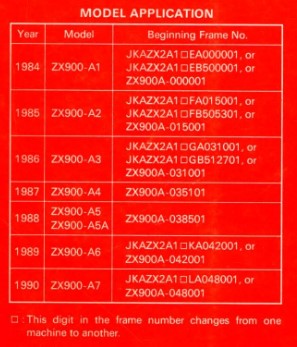
The easiest way to identify your version up to is from the 10th digit of the VIN (not always the frame number!) which is the year of manufacture – this applies to both Japanese (A) and US (B) bikes.
| 10th Digit | E | F | G | H | J | K | L | M | N | P | W | X | Y | 1 | 2 | 3 |
| Year | 84 | 85 | 86 | 87 | 88 | 89 | 90 | 91 | 92 | 93 | 98 | 99 | 00 | 01 | 02 | 03 |
| Version | A1 | A2 | A3 | A4 | A5/A | A6 | A7 | A8 | A9 | A10 | A11 | A12 | A13 | 14 | A15 | A16 |
Note 1. Uses a repeating 30-character set to represent 30 years. Letters I, O, Q, U, Z & 0 (zero) not used.
Note 2. A guess for 3rd gen (+A11) bikes. They may have a different VIN entirely!
JKAZX2A1V E A000001 = 1984
JKAZX2A1V M B556001 = 1991
If you do not have a 17-digit VIN then it is a RoW bike and you identify your year from the 6-digit production numbers listed below.
Production Numbers
You would assume that Kawasaki rounded up to ensure that the new version frame numbers start from a nice clean number, so obviously these AREN’T the actual version production numbers which would be lower,
So although I cannot confirm the source of this data, cyclechaos.com has more defined values for 3rd generation production numbers than any other site I have found. This indicates that the actual production is 1/3 of the theoretical. Since they must have based this on *something* I have taken an educated punt and use these figures for production estimates.
*asterix: indicates these figures not the general FSM number
**asterix: indicates guesstimate.
The data indicates actual production is about 1/3 of theoretical for 3rd gen bikes – I have used this figure to estimate ROW production numbers for other versions.
- A1 1984: 15,000 ROW + 5,300 US = 20,300
- A2 1985: 015001 – 031000 = 16,000 ROW + 7,400 US = 23,400
- A3: 1986: 4,100 ROW + 6,350** US = 10
- A4: 1987: 3,400
- A5: 1988: 3,500
- (A5A: 1988: 041025 – 41494 = 469)
- A6: 1989: 6,000
With no actual figure I have used the average of A1/A2 production for US A3 numbers.
Theoretical 1st Generation Production Max:
US: 19,050* ROW: 48,000
Second-generation bike
- A7 1990: 048001 – 056000 = 6,000
- A8: 1991: 056001 – 063000 = 7,000 [Japan: 058183 – 059848]
- A9: 1992: 063001 – 068000 = 5,000 [Japan: 068921~070887]
- A10: 1993: 068001 – 078000 = 10,000
Theoretical 2nd Generation Production Max: 28,000
Third-generation bike
- A11: 1998: 078001 – 080555 = 2,555
- A12: 1999: 085001 – 087079 = 2,079
- A13: 2000: 090001 – 090474* = 474
- A14: 2001: 092001 – 092690* = 690
- A15: 2002: 095001 – 097000 = 400**
- A16: 2003: 097001 – 097162 = 162
3rd Generation Production: 6,360 (33% of theoretical max 19,162)
Summary
From chassis numbers the theoretical production maximum is 114,212 and if I were to apply the 1/3 rule across the board this is only around 38,000. Which sounds too low. This 2018 article refers to 70,000 which is much more plausible. The problem is that almost no online articles give a reference source nor have I found even TWO online articles with estimated GPz production numbers. The only accurate information would likely have to come from Kawasaki themselves – good luck with that!
But I’ll always throw out a flat-earth theory, so here we go.
From this page the maximum theoretical production of the Z1 is about 144,000, and if the estimated production is 85,000 then this is about 60%. And 60% of the theoretical GPz maximum is 68,000. So pretty close to rhe 70,000 used above.
I swear I haven’t used the Z1 info to simply confirm my theory – this is purely how the math came out. But it would be nice to have a method to more accurately define production.
Engine Numbers
The engine number is stamped on the top of the gearbox and easily readable.
From the Haynes Service Manual – so need to take with a grain of salt.
Buck. R reports his 1984 A1 engine was only 27 or 28. This is quite feasible as Australia had bikes on the showroom floor in late 1983, as our summer sales season is often the first world market for japanese bikes.
Anecdotally there seems a link for early (A1/2) bikes with frame & engine numbers being close – I’d suggest less than a couple of thousand units is pretty good. The Bonhams bike below shows in 1991 it was still close-ish in some markets, however the difference on my Aussie A8 is a whopping 8,140.

Of course the detailed data just does not exist and as time goes on the variance is expected to get worse. So this although this information *may* have been sent to regional headquarters it may only ever have been on paper & recorded by the actual dealers at the time of sale.
Engine Year Stamping
In Feb 2021 Tony.G has noticed a casting on the head (A/90) that seemed to correlate with the bikes manufacturing year (1990). He has two other GPz900R’s with the stamp (A/8) representing a 1988 bike and the stamp (A/9) representing a 1989. This was supported by another owner of 1984 bike who reported the stamp as (A/4) and my 1991 which has (A/91). This seems a very simple way to check if the bikes engine ‘matches’ it’s year of frame manufacture.
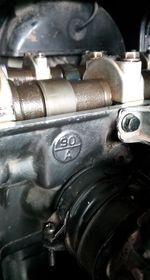
Motorcycle Specifications
https://www.motorcyclespecifications.com/?s=gpz900r
A really nice site that even attempts to break down different bikes into their manufacturing releases. A great starting point for general info on any bike.
CLICK TO OPEN LINK IN NEW TAB
WikipediA
Typical Wikipedia general information. Another insightful page shows that despite her age (she’s the oldest) the GPz990r *still* sits mid-pack in the https://en.wikipedia.org/wiki/List_of_fastest_production_motorcycles_by_acceleration. What would be *really* interesting to find out is how many 900cc motorcycles have been built & released *after* the GPz900r but still can’t out-drag it – can’t be many!
CLICK TO OPEN LINK IN NEW TAB
BikesWiki
Another basic quick info page – nice images and specifications.
CLICK TO OPEN LINK IN NEW TAB
2020 Secondhand value
Not that I’ll ever sell my bike, but it’s always curious to see what they are worth.
Nov 2020 Prices
Have to highlight this 1984 A1 that has travelled 105,000km for the bargain price of AU$25,000. Looks OEM except for the seat?

Sounds crazy but old vehicles, like art, often become an investment commodity and the GPz900r certainly has a significant role in motorcycling history. As such the original A1 bikes (frame <15000) are probably the version that makes economic sense to keep as original as possible and not be ridden (just started now and then).
Whilst I’m not normally one for putting machinery onto the display shelf, I’m also not fussed if some folks start trying to generate investor interest in the A1. It will preserve the legacy of the original design (only really king-of-the-road for 1984) and there are plenty of later bikes available for those who still want to ride and/or modify it. So just buy another!
There are two other GPz900r’s for sale, both listed as 1990 versions . A nice tidy version that has travelled 69,000km for $8,500 and another missing some fairings and a bit rough around the edges, but only travelled 36,500km for $2,999.
So not are these a huge drop from the investor asking price for the A1, but shows there is still a lot of variance still exists in the market.


2014 Prices
This pristine 1991 with a full rebuild, including engine went for AU$5,716 at an English auction in 2014. IMHO that’s an absolute bargain.
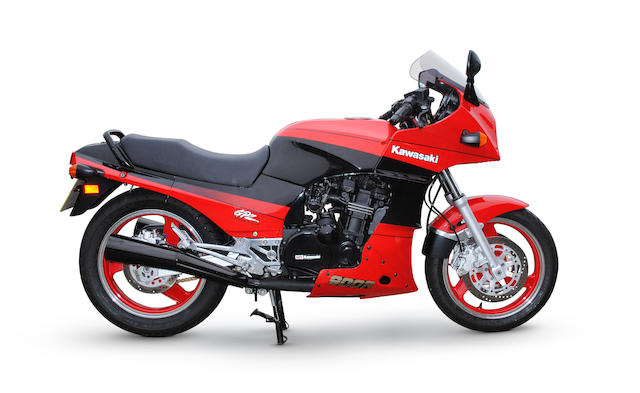
The origin of the Ninja name
The Japanese reference to Ninja has been retrospectively attributed to a 4th century assassin who disguised himself as a female and killed two opposing chiefs. Arguably quite an apt description of the bike as it defeated bigger more ‘masculine’ opponents like the K1. However the covert nature of Ninja warfare was considered dishonourable and beneath the honor of the samuri.
The ‘Ninja’ name was initially only used in the US market for the GPz900r. This branding can be attributed to Mike Vaughan, then Director of Marketing for Kawasaki U.S.A, and online research suggests the idea actually started with the original GPz750 bike when it was first seen in 1979/80. The US team were keen on the name but due to the ‘undesirable’ Japanese definition Kawsaki weren’t and a new advertising company engaged at the time actually proposed The Panther.
The info links below discuss different re-collections of the origin of the Ninja name.
- 2016 – Rideapart: Kawasaki Shares Tale of the Ninja
- 2011 – Ridermagazine – Crouching Panther, Hidden Ninja
- 2016 – Motorcycle News (MCN): Why the birth of the Ninja dynasty was the dawn of modern motorcycling
So phenomenally successful was the branding that the Ninja name expanded to all markets and it is now universally known throughout the motorcycling world as referring to a Kawasaki sportsbike. And I’d suggest the Ninja name, it’s dis-association from the upper class and it’s edgy definition were (and is) a major contributing factor to the bike’s cult status in Japan.
2019 - CMM - Best Bikes of 1984
It was the year that many reckon the first bike of the modern era was launched. Kawasaki’s 155mph GPZ900r, which went on sale in 1984, featured an across-the frame four-cylinder liquid cooled engine and aerodynamics that would provide the template for sports bike over the next three decades or more.
Nice detailed reviews on the different motorcycles that were available in 1984. This link uses pressreader.com which allows some content to be viewed for free (like this) but others require payment.
CLICK TO OPEN LINK IN NEW TAB
2018 - Classic Motorcycles Retrospective
The phrase ‘broke the mould’ is often over used but not in this case; apart from the fact the 900R was visually perfect for the period its spec would stun riders that had enjoyed a diet of un-faired, air cooled heavy weights
Nice review on the development and the impact of the GPz900r. Also includes the snippet of info that the bike’s first public appearance was the 1983 Paris Motor Show (October I think) which was a popular choice for Japanses manufacturers at that time.
CLICK TO OPEN LINK IN NEW TAB
2016 - Rideapart: Kawasaki Shares Tale of the Ninja
Dr. Ohba, then President of Kawasaki Heavy Industries, was also present for the launch. You might say it was a big deal.
A few more snippets of info filling in the spaces around the Ninja name, also making the observation that the 1983 launch was a pretty big event for Kawasaki, including superbike racing legend Wayne Rainey.
CLICK TO OPEN LINK IN NEW TAB
2015 - Motorcycle News (MCN): Article on the GPz900r and 'Ninja' range
This is where it all started – the first Ninja. Only branded ‘Ninja’ in the USA, the GPZ was the fastest bike in the world, debuted the liquid-cooled inline-four engine yet managed to stop and turn corners properly. It laid the basic principles for today’s sportsbike.
Nice quick summary of the impact of the GPz900r and the birth of the iconic Ninja brand now universally known as describing a performance motorcycles. The great part of this article is 4 great photos of Jay Gleason doing a burn-out at the bikes Press Launch at Laguna Seca in 1983!
CLICK TO OPEN LINK IN NEW TAB
2013 - Classic Motorcycles Buying Guide

Overview of what to look out for if buying a secondhand GPz900r. See notes on Pricing that attempts to explain why A1 bikes are more expensive.
CLICK TO OPEN LINK IN NEW TAB
2012 - Classic Motorcycles: Kawasaki's king-of-the-road, the GPz900r
During the early 80’s the world sat around awaiting the next big thing in motorcycling. Big capacity, air-cooled, muscle bikes had become the norm and most expected this march to gain momentum, few however expected Kawasaki’s next move and the result changed the face of the Superbike forever.
An interesting retrospective and evaluation of the bike, not only discussing it’s history and legacy but how it fits into the motorcycling world 17 years after it was last released in the UK (1996).
CLICK TO OPEN LINK IN NEW TAB
2011 - Ridermagazine - Crouching Panther, Hidden Ninja
Apparently Mike first proposed the name in 1980—three decades ago!—for the GPz750, which was introduced for 1982. The folks at Kawasaki Motors Corp., U.S.A. were all for it, but higher-ups at Kobe, Japan-based Kawasaki Heavy Industries put the kibosh on the idea.
A bit more info (and cross-referencing of facts) into the origin of the Ninja name proposed by Mike Vaughn, Kawasaki US Marketing Director.
Annoyingly this article is actually based on an ridermagazine.com article written by Clement Salvadori, however apart from the single page image I can’t locate the original article, even though I’ve found around 40 other articles he has written on motorcycles!

CLICK TO OPEN LINK IN NEW TAB
2010 - IMCDB : The 'Top Gun' bike is NOT the GPz750!
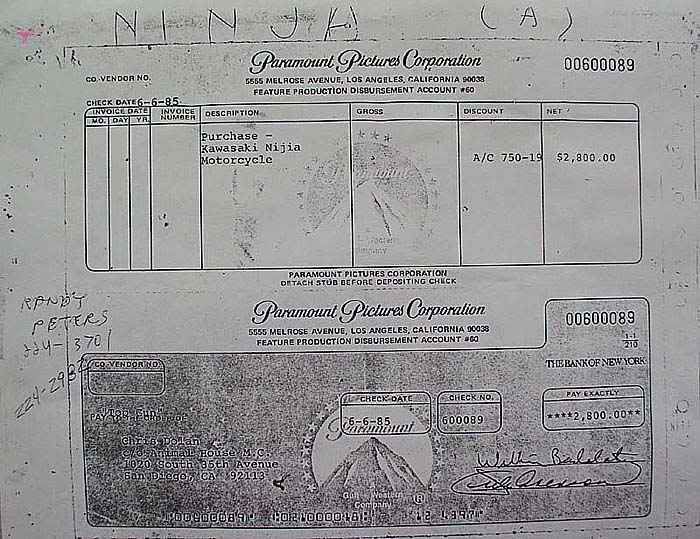
Heck I love a conspiracy theory, but for me this discussion pretty well closes the door on it – hard to argue with a receipt! This info has been bounced around on many forums (and regularly resurfaces) but folks – it’s a GPz900r!
I really enjoy the story that Kawasaki wouldn’t just give the studio a bike (gold!) but they simply *had* to have it – so they de-badged and repainted. I mean really, are studio executives that shallow? LOL. This link suggests Tom Cruise actually owns the actual GPz900r (however I don’t believe half of what I read on the net), if so I wonder if I can get him to add the bike to the database? I’m guessing the real challenge is simply figuring out how to get past his protective minions…..
CLICK TO OPEN LINK IN NEW TAB
2009 - Motorcycle News (MCN): Why the birth of the Ninja dynasty was the dawn of modern motorcycling
As senior technician at Kawasaki UK, Alex Dell was one of the first people outside Japan to see a 900R up close. “We got a pre-production bike for pre-launch tests and we were all gawping at it,” he said. “It was ultra secret at the time, and in silver – not the final colours. We hadn’t set eyes on anything like it before. It was such a different bike, with radical, futuristic styling. There was so much new technology in it.”.
The title pretty well says it all. Also includes info how we got Ninja rather than Panther….
CLICK TO OPEN LINK IN NEW TAB
2009 - Visordown: Katana vs GPz900R (broken)
This article is the perfect example of what I am trying to achieve with the site.
This was a great article comparing the Katana with the GPz900R. Both were fantastic bikes & legends and really represented the stepping stone between the different generations of performance motorcycles.
But now all you get from the link is the title. But you do get 17 ads that have nothing to do with motorcycles…..
Feb 2021
For months I’ve tried to contact Visordown to advise of the problem – of course they only have the ubiquitous contact email form and no-one ever replies. I also tried to contact the well-known journalist (Colin Goodwin) on LinkedIn but there has been no response.
So this is the problem – people simply forget and don’t care, so sadly I’m guessing this piece of GPz900R history is lost. Hopefully I can backup as much of this information as possible.
CLICK TO OPEN LINK IN NEW TAB
1991 - MCS - Same reviewer as 1984, 7 years later!
Back in ’84, of course, it was the ultimate rip-snorter. In that year my proddy-race GSX1100 was brim-full of illegal Yoshimura gear, yet the bloody bog-stock Ninjas still came steaming past before the end of the Snetterton straight. These days a ZZ-R would leave the 900 for dead and Suzuki’s GSX-R1100, 501b lighter as well as 10 horses more powerful, would make it look positively sluggish round Snetterton.
A really insightful review of the 1991 GPz900r by the same Bike Magazine reviewer who was at the TT track for the 1984 comparison!He not recalls the impact of the bike in 1984, but also just how much performance motorcycle have advanced since then. The GPz900r, being fundamentally the same bike, clearly shows it’s age.
At the top end of town; if you were standing still you were going backwards.
Anyway he still considers it a bargain sports-tourer!
CLICK TO OPEN LINK IN NEW TAB
1990 - Australian Dealership Brochures (A7)
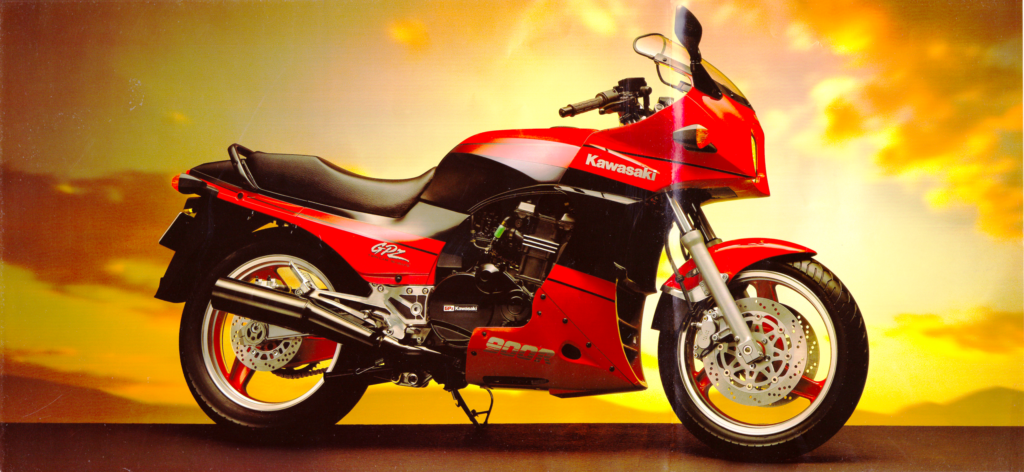
A shout to Mike inWA who sent me this brochure to scan, Images 2048 & 2560px high-res optimised for web viewing.
CLICK TO OPEN LINK IN NEW TAB
1984 - Bike Magazine: Road Test of 5 bikes
Ultimately, however, everyone voted for the Kawasaki. Over £300 cheaper than the Honda or Yam, it equals or betters both as a street racer, has superb brakes, and always feels more exciting. Which is surely what a sports motorcycle is all about. If it wasn’t for the BMW and Laverda, picking the Ninja as overall winner would be easy. But few could dispute the K100RS’s ability to live up to its maker’s promise. Nor is the Jota the worse off for Laverda’s refusal to totally sanitise their products: quite the opposite. All three are winners, although if you’ve always reckoned that cheapest is best, Kawasaki have proved that the best, for once, is also the cheapest.
A great article road-testing and comparing these five bikes from 1984;
- BMW K100RS
- Honda VF1000F
- Kawaskai GPz900r
- Laverda Jota
- Yamaha FJ1100
The value of this article is that the reviewers are riding the bikes hard on a TT track and they are comparing the bikes with regard to not just the performance & handling values of 1984, but the public expectation of a sports motorcycle at that the time.
This is best illustrated by the big red cross the BMW gets for not having a pillion grab rail – today’s superbikes probably don’t even have a pillion seat!
CLICK TO OPEN LINK IN NEW TAB
1984 - Motorcyclist
The Ninja is a very exciting motorcycle, a leap forward for large-displacement sporting bikes. If you think the essence of motorcycling is the sensation of leaning into corners, you need one.
Another great review discussing the technical, the impact and the competition.
CLICK TO OPEN LINK IN NEW TAB
1984 - Cycle Magazine: Road Test on the GPz900r
You wear this motorcycle like a red badge of outrage. It could make a highway saint into the happiest, hardest road criminal around.
A really nice technical assessment of the GPz, and expertly sums up the Kawasaki engineers clever work and intent of the bike. Super-retro scanned magazine pages as well and quick links to related bikes like the 1983 ZX750 Turbo.
CLICK TO OPEN LINK IN NEW TAB
1984 - Australian Dealership Brochures (A1-A6)
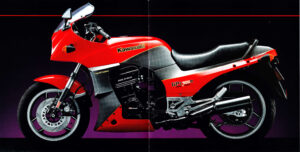
A couple of scanned Australian Brochures. Images 1480px high optimised for web viewing.
CLICK TO OPEN LINK IN NEW TAB
1984 - Racing Kit Manual
1984 - US Brochure
1983 - Press Kit
Lighter than some 750s, more powerful than some 1100s – – it is the fastest Kawasaki streetbike ever built.
A shout to Sam.H at the Kawasaki GPz900r Appreciation Group for tracking down the 23-page original Press Kit. This is a great read that gives great info on the bike (eg dyno readouts) and insight as to the technological design.
CLICK TO OPEN LINK IN NEW TAB
1983 - Australian Motorcycle News - Paris 1983 Show
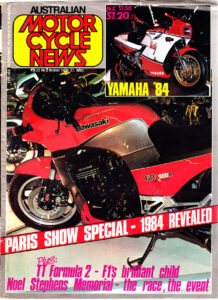
Articles describing the first pubic viewing of the bike and what the competition was releasing in 1984. Pages scanned and linked in a carousel, also high-res scans of the bikes photos uploaded as well.
Although the bike gets the cover shot the articles clearly indicate it wasn’t expected to be the performance bike of 1984.
As only 8 pages were printed in colour ads in these would have been worth a pretty penny so I’ve included them all, interestingly it shows the level of Kawasaki’s advertising sophistication compared to the other Japanese manufacturers at that time.
And sorry mate, but I couldn’t help but smile at Page 67 where one of the feature riders for the Castrol 6-Hour is Wayne Gardiner!
CLICK TO OPEN LINK IN NEW TAB
The net is great for sourcing information – but as quickly as it appears it can disappear. For all links I try to contact site owners directly, for courtesy and to remind them that this info is still of great interest to their readers. If you know of a link please send it through!
GPz900R (ZX900) Database
Number of owner contacted & confirmed bikes.
A1
A2
A3
A4
A5
A5A
A6
A7
A8
A9
A10
A11
A12
A13
A14
A15
A16
Top Gun
About the Site
My family loves older vehicles, the newest one we own is 2003! But I am acutely aware of the ownership complexities especially:
- they often need more 'hands-on' mechanical work &;
- there often isn't any local expertise from the service centres;
- there is often no new parts available from the manufacturer;
- parts often have to be sourced 2nd-hand or from overseas.
So we often end up doing a lot of the research & work ourselves and this information gets stored either locally with the bike or online forums - although finding the useful parts in these forums isn't always simple.
The original goal of the site was simply somewhere for me to record service work & contacts on my GPz900r so that my kids (the one that likes bikes anyway!) could easily access it - it doesn't concern me if it was publicly available.
I then realised that with this online structure in place I could also offer it to other owners, and the site could potentially expand to record other owners experiences and expertise , meaning we can learn from others but also pass on this knowledge to subsequent owners of these wonderful motorcycles.
At least Covid-19 has given me plenty of spare time to pursue my passion for the motorcycle!

Location
Adelaide
South Australia
gpz900r@motoshoot.com.au
Timeline
1983 - Honda XR200
1984 - wanted a GPz
1985-2013 - cars+family
2014 - finally got one!
Disclaimer
The information provided on this site (or links) is personal experiences from non-professional home-mechanics, so neither it's accuracy nor it's validity can be confirmed. If you need professional advise please visit your local Kawasaki dealership or a qualified industry professional.
Like riding any motorcycle, at the end of the day the only opinion that really counts is your own!


